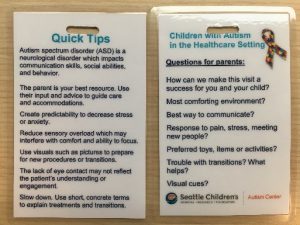We hope that your child never is in need of an emergency department visit. It’s always good to be prepared, so just in case bookmark this blog!
Patients with Autism in the Emergency Department
September 18, 2017
Going to the Emergency Department with any child is unnerving. Taking a child with autism is even more so with all the complications that autism brings. Waiting is hard. Explaining baseline behavior is too.
There are many unknowns with kids with autism such as unusual reactions to medications and elevated behavioral responses to procedures as simple as blood pressure and temperature. In addition, parents face the scrutiny of everyone within earshot of our kids who frequently are loud and draw lots of attention. We feel the stares and we sense the judgment. We’ve been here before in the grocery store, the restaurant, and yes, even at Seattle Children’s Hospital as we wait along with others for services.
Will your child ever need to go to the Emergency Department? Hopefully not but you might be surprised to learn how common a trip to the ED is for ALL kids, including ours. Given that, is it possible to be prepared ahead of time? For answers, we went straight to the source with Seattle Children’s Emergency Department staff. We have also included a handy glossary of terms that you may encounter in an ED visit. If a provider uses a term you are unfamiliar with, don’t hesitate to ask for an explanation!
How many children and adolescents with ASD do you see in the ED?
What are some of the concerns that families bring to the ED?
What are some of the common challenges that occur for patients and parents in the ED?
What are some of the common challenges that occur in the ED for providers serving patients with ASD?
What can parents do to prepare before their child has reason to need a visit to the ED?
Upon arrival in the ED, what can parents do to lessen the stress for all?
What has been done at Seattle Children’s to lessen the stress for patients and families in the ED?
What do you want patients with ASD and their parents to know if they need to see you in the ED?
Glossary of Terms You Might Hear in the ED
Attending: An attending is a physician/medical doctor who is in charge of your care and supervises trainees such as residents and fellows.
Resident: A resident is a physician/medical doctor who practices medicine in a hospital or clinic under the supervision of an attending physician.
Fellow: A fellow is a physician/medical doctor who has completed residency and has chosen additional training in a specialty or subspecialty and practices under the supervision of an attending physician.
Labs: Labs usually refers to a blood draw, urine or stool sample for diagnostic testing.
Triage: Triage is the process of determining the priority of patients’ treatments based on the severity of their condition.
Medication reconciliation: Medication reconciliation is the process of updating the record of current medications.
Imaging/Scans: Imaging or scans refers to diagnostic procedures such as MRI, CT, X-ray.
NPO: Nil per os – Latin term meaning nothing by mouth (food or liquids).
PRN: Pro re nata – Latin term meaning as needed or when necessary.
Tips
If you are concerned that your child will resist doing something in the standard way, ask if it is possible to do it a different way. I recall an ED visit with my child in which an X-ray was needed. She would not lie down for it so we tried it standing up and it worked. This won’t be possible in every single case but it’s always worth asking.
Providers in the ED are always busy and won’t always have time to check your child’s chart if they are patients at Seattle Children’s. You can help by having answers ready to some key questions. Take a look at this card we use at our Autism Center.
